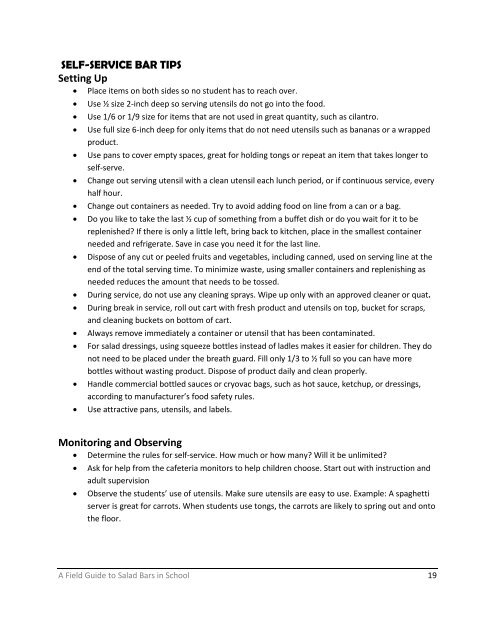A Field Guide To Salad Bars In Schools - Minnesota Department of ...
A Field Guide To Salad Bars In Schools - Minnesota Department of ...
A Field Guide To Salad Bars In Schools - Minnesota Department of ...
Create successful ePaper yourself
Turn your PDF publications into a flip-book with our unique Google optimized e-Paper software.
SELF-SERVICE BAR TIPS<br />
Setting Up<br />
• Place items on both sides so no student has to reach over.<br />
• Use ½ size 2-inch deep so serving utensils do not go into the food.<br />
• Use 1/6 or 1/9 size for items that are not used in great quantity, such as cilantro.<br />
• Use full size 6-inch deep for only items that do not need utensils such as bananas or a wrapped<br />
product.<br />
• Use pans to cover empty spaces, great for holding tongs or repeat an item that takes longer to<br />
self-serve.<br />
• Change out serving utensil with a clean utensil each lunch period, or if continuous service, every<br />
half hour.<br />
• Change out containers as needed. Try to avoid adding food on line from a can or a bag.<br />
• Do you like to take the last ½ cup <strong>of</strong> something from a buffet dish or do you wait for it to be<br />
replenished? If there is only a little left, bring back to kitchen, place in the smallest container<br />
needed and refrigerate. Save in case you need it for the last line.<br />
• Dispose <strong>of</strong> any cut or peeled fruits and vegetables, including canned, used on serving line at the<br />
end <strong>of</strong> the total serving time. <strong>To</strong> minimize waste, using smaller containers and replenishing as<br />
needed reduces the amount that needs to be tossed.<br />
• During service, do not use any cleaning sprays. Wipe up only with an approved cleaner or quat.<br />
• During break in service, roll out cart with fresh product and utensils on top, bucket for scraps,<br />
and cleaning buckets on bottom <strong>of</strong> cart.<br />
• Always remove immediately a container or utensil that has been contaminated.<br />
• For salad dressings, using squeeze bottles instead <strong>of</strong> ladles makes it easier for children. They do<br />
not need to be placed under the breath guard. Fill only 1/3 to ½ full so you can have more<br />
bottles without wasting product. Dispose <strong>of</strong> product daily and clean properly.<br />
• Handle commercial bottled sauces or cryovac bags, such as hot sauce, ketchup, or dressings,<br />
according to manufacturer’s food safety rules.<br />
• Use attractive pans, utensils, and labels.<br />
Monitoring and Observing<br />
• Determine the rules for self-service. How much or how many? Will it be unlimited?<br />
• Ask for help from the cafeteria monitors to help children choose. Start out with instruction and<br />
adult supervision<br />
• Observe the students’ use <strong>of</strong> utensils. Make sure utensils are easy to use. Example: A spaghetti<br />
server is great for carrots. When students use tongs, the carrots are likely to spring out and onto<br />
the floor.<br />
A <strong>Field</strong> <strong>Guide</strong> to <strong>Salad</strong> <strong>Bars</strong> in School 19
















